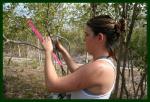HOME || CHAPTER OUTLINES || PPT PRESENTATIONS || BIOLOGICAL ANIMATIONS || ONLINE LABS || DAILY ASSIGNMENTS || FLASHCARDS || COLLEGE BOARD
As an undergraduate student at Kennesaw State University, I had the distinguished honor of being asked to participate in a directed research study whereby I assisted in collecting and analyzing data regarding the physiological responses to drought of three tree species in the dry deciduous forests of Dzibilchaltun, Mexico (a globally threatened ecosystem).
Abstract:
This study was conducted in the dry deciduous forest of Dzibilchaltun, Yucatan, Mexico at the height of the dry season, May 2006. Research objectives included collection of the physiological data for three tree species that differ in leaf flushing pattern and dominate the dry forest of Dzilbchaltun. The species studied were Gymnopodium floribundum, Diospyros cuneata (both evergreen), and Piscidia piscipula (a brevi-deciduous species). Photosynthetic data were collected using a Heinz-Walz GmbH MINI-PAM Photosynthesis Yield Analyzer, and water potential data were collected using a Scholander-type pressure chamber. Light saturation curves indicate that P. piscipula maintained higher average apparent electron transport rates, light saturation points and water potentials, and a lower average NPQ (heat dissipation) value as compared to D. cuneata and G. floribundum. Comparisons of D. cuneata and G. floribundum revealed that D. cuneata maintained a lower average electron transport rate, light saturation point, and NPQ; and a higher average water potential as compared to G. floribundum We found high variability in apparent electron transport rate between individuals of G. floribundum, and all water potential measurements for this species were beyond the scale of the pressure chamber. Our data suggest potential differences in the physiological response to drought of these three species.
Materials & Methods:
Data were collected for one leaf per individual and three individuals per species using a Heinz-Walz GmbH MINI-PAM Photosynthesis Yield Analyzer. By comparing pre-dawn fluorescence measurements to day long measurements, we obtained an indication of the extent to which our different species were photo-inhibited. Pre-dawn and midday water potentials were collected using a Scholander-type pressure chamber.
Conclusion:
Preliminary data suggest that P. piscipula (brevi-deciduous) maintained a higher average apparent electron transport rate (ETR), a higher light saturation point, a higher maximum water potential, and a lower average NPQ (heat dissipation) value as compared to the two evergreen species. Comparisons of D. cuneata and G. floribundum revealed that D. cuneata maintained a lower average electron transport rate, light saturation point, and NPQ; and a higher average water potential as compared to G. floribundum. Data also indicated high variability in apparent electron transport rate between individuals of G. floribundum. Although our data suggest species specific differences in response to drought, data presented are preliminary and further research is necessary to draw solid conclusions. Our plans for further research on all three species include gas exchange measurements during both the dry and rainy seasons, additional measurements of water potentials, studies relating to the differences found in the physiology between trees belonging to the same species, and an increase in sample size.
Acknowledgements:
We would like to thank the following persons for their assistance during this study: Jose Carlos Cervera, Jose Luis Andrade, Lius Sima, Robert Au, Cassandra Reyes, Thomas McElroy, and Flavia Bitussi.
This study received funding from NSF/RUI grant.
References:
Brodribb, T.J., Holb(rook, N.M., Gutierrez, M.V. 2002. Hydraulic and photosynthetic co-ordination in seasonally dry tropical forest trees. Plant, cell and Environment. 25: 1435-1444.
Gonzalez-Iturbe, J.A., Olmsted, I., Tun-Szul, F. 2002. Tropical dry forest recovery after long term Henequen (sisal, Agave fourcroydes Lem.) plantation in northern Yucatan, Mexico. Forest Ecology and Management. 167: 67-82.
Maxwell, K., Giles, N.J. 2000. Chlorophyll fluorescence – a pratical guide. J. Exp. Botany. 51: 659-668.
Molles, M.C. 2005. Ecology: concepts and applications. McGraw-Hill Press, NY, pp.157-160.
Reich, P.B., Walters, M.B., Ellsworth, D.S., 1992. Leaf life-span in relation to leaf, plant, and stand characteristics among diverse ecosystems. Ecological Monographs. 62: 365-392.




